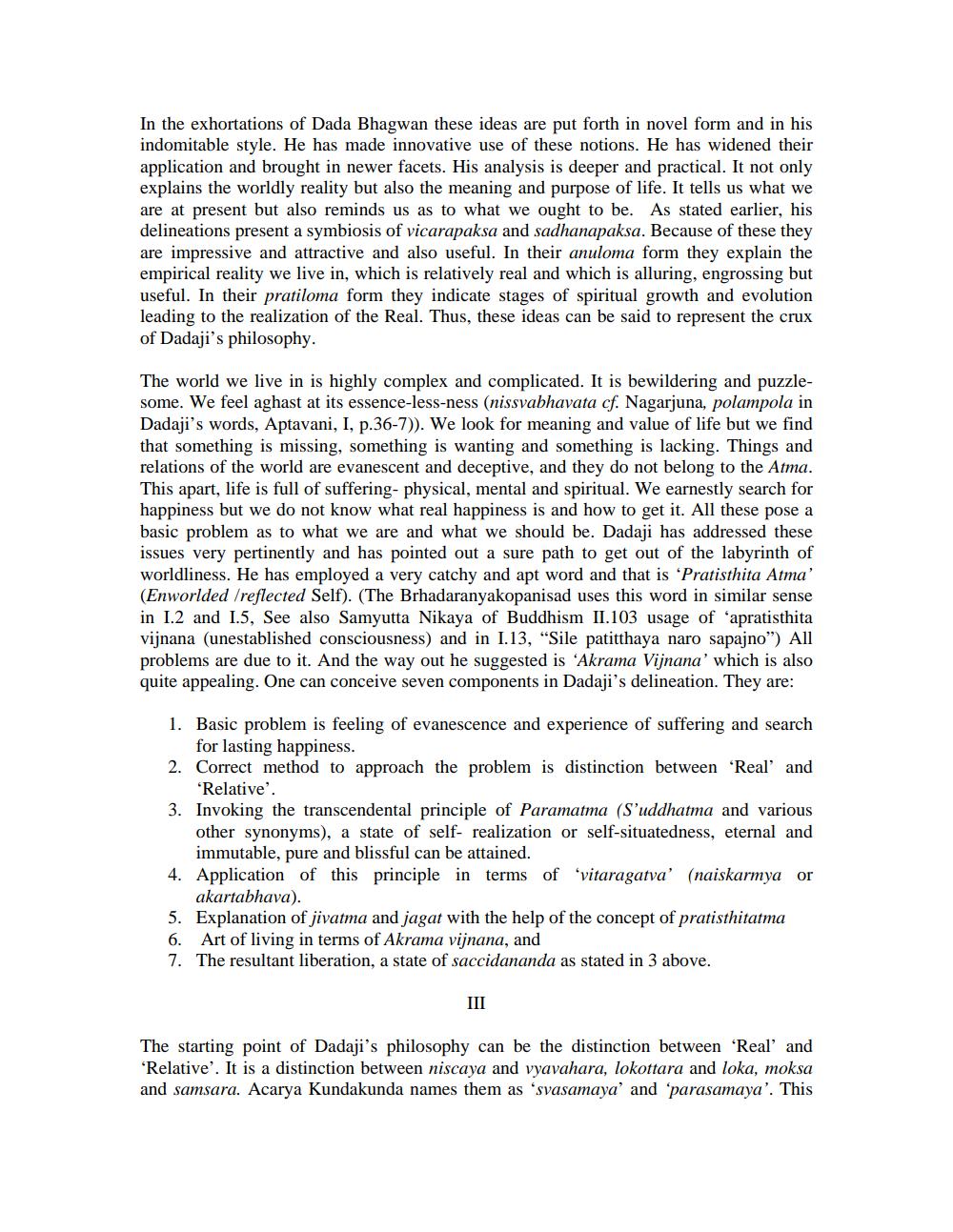Book Title: Concepts of Parmatma Antaratma Anatma in Philosophy of Dada Bhagwan Author(s): S R Bhatt Publisher: S R Bhatt View full book textPage 8
________________ In the exhortations of Dada Bhagwan these ideas are put forth in novel form and in his indomitable style. He has made innovative use of these notions. He has widened their application and brought in newer facets. His analysis is deeper and practical. It not only explains the worldly reality but also the meaning and purpose of life. It tells us what we are at present but also reminds us as to what we ought to be. As stated earlier, his delineations present a symbiosis of vicarapaksa and sadhanapaksa. Because of these they are impressive and attractive and also useful. In their anuloma form they explain the empirical reality we live in, which is relatively real and which is alluring, engrossing but useful. In their pratiloma form they indicate stages of spiritual growth and evolution leading to the realization of the Real. Thus, these ideas can be said to represent the crux of Dadaji's philosophy. The world we live in is highly complex and complicated. It is bewildering and puzzlesome. We feel aghast at its essence-less-ness (nissvabhavata cf. Nagarjuna, polampola in Dadaji's words, Aptavani, I, p.36-7)). We look for meaning and value of life but we find that something is missing, something is wanting and something is lacking. Things and relations of the world are evanescent and deceptive, and they do not belong to the Atma. This apart, life is full of suffering- physical, mental and spiritual. We earnestly search for happiness but we do not know what real happiness is and how to get it. All these pose a basic problem as to what we are and what we should be. Dadaji has addressed these issues very pertinently and has pointed out a sure path to get out of the labyrinth of worldliness. He has employed a very catchy and apt word and that is 'Pratisthita Atma' (Enworlded /reflected Self). (The Brhadaranyakopanisad uses this word in similar sense in I.2 and 1.5, See also Samyutta Nikaya of Buddhism II.103 usage of 'apratisthita vijnana (unestablished consciousness) and in 1.13, “Sile patitthaya naro sapajno") All problems are due to it. And the way out he suggested is 'Akrama Vijnana' which is also quite appealing. One can conceive seven components in Dadaji's delineation. They are: 1. Basic problem is feeling of evanescence and experience of suffering and search for lasting happiness. 2. Correct method to approach the problem is distinction between 'Real' and 'Relative 3. Invoking the transcendental principle of Paramatma (S'uddhatma and various other synonyms), a state of self- realization or self-situatedness, eternal and immutable, pure and blissful can be attained. 4. Application of this principle in terms of 'vitaragatva' (naiskarmya or akartabhava). 5. Explanation of jivatma and jagat with the help of the concept of pratisthitatma 6. Art of living in terms of Akrama vijnana, and 7. The resultant liberation, a state of saccidananda as stated in 3 above. III The starting point of Dadaji's philosophy can be the distinction between Real' and Relative'. It is a distinction between niscaya and vyavahara, lokottara and loka, moksa and samsara. Acarya Kundakunda names them as 'svasamaya' and 'parasamaya'. ThisPage Navigation
1 ... 6 7 8 9 10 11 12 13 14 15 16 17 18 19 20 21 22 23 24
